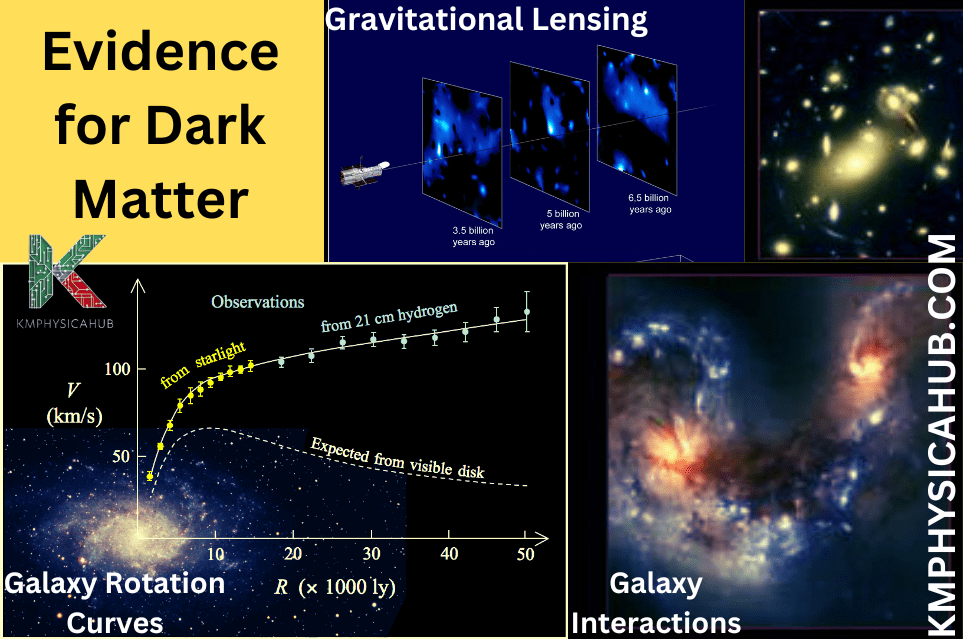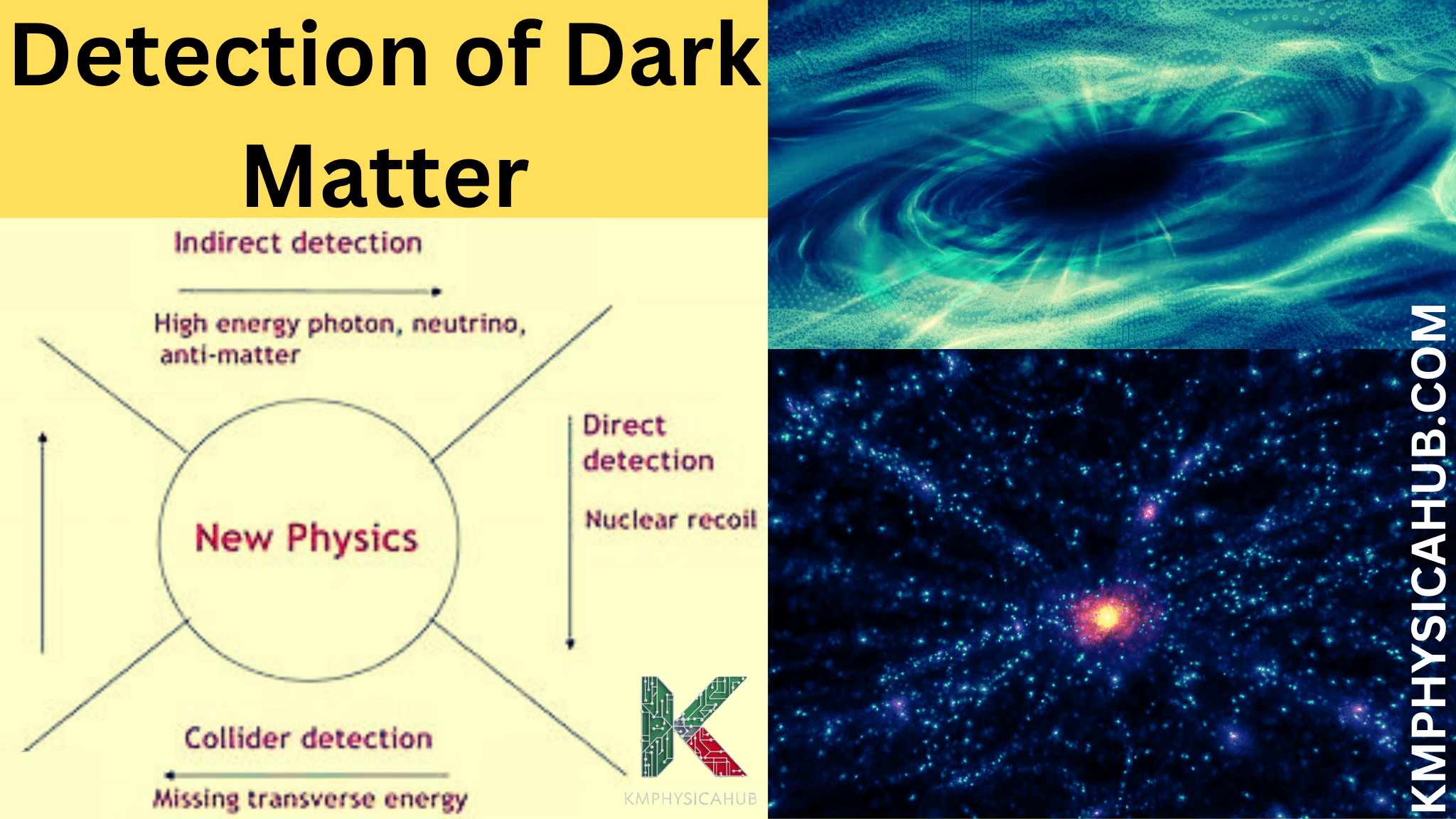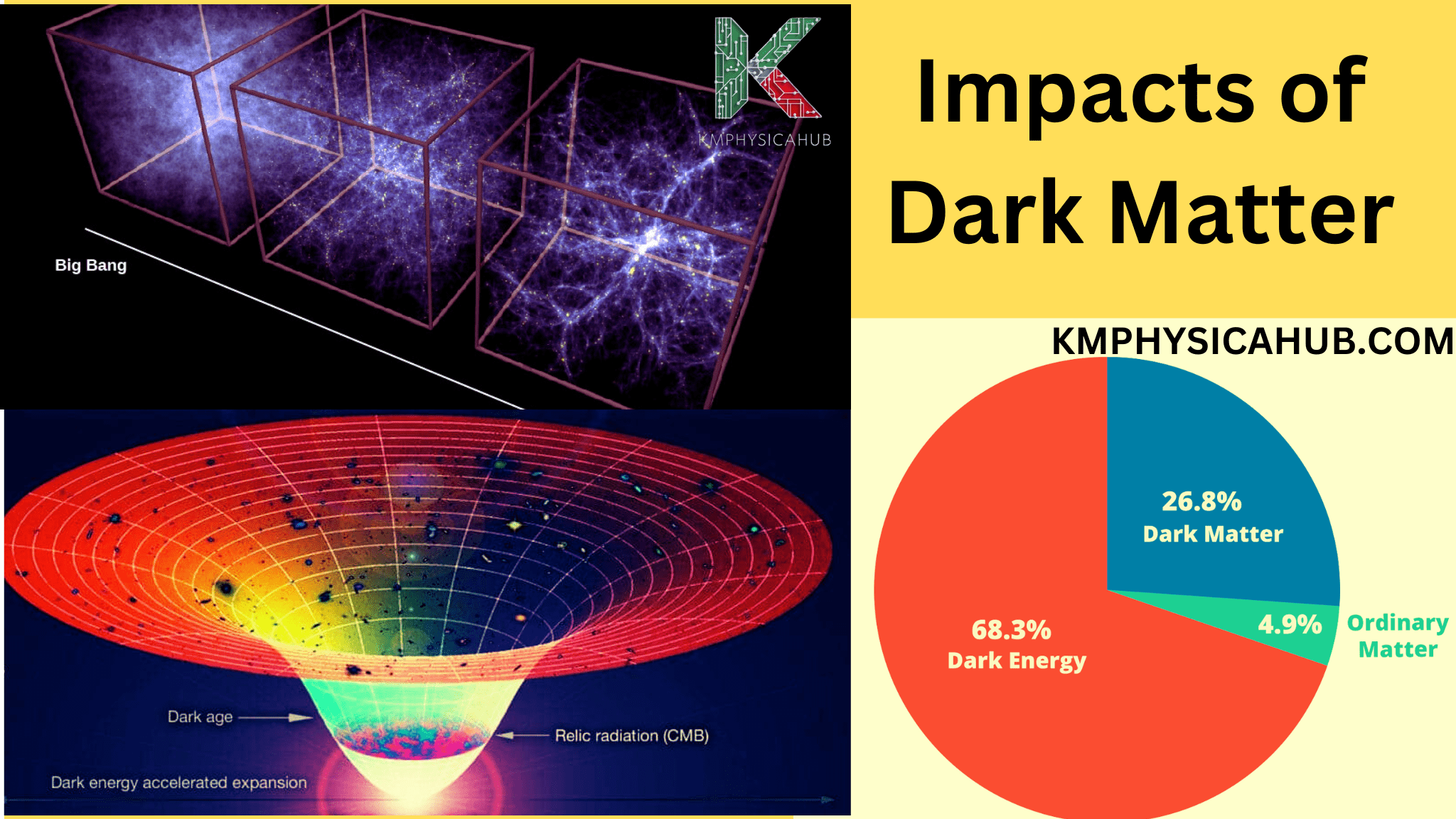Understanding the Detection Methods, Theories, and Impact of Dark Matter
Dark Matter
Dark matter refers to a type of matter whose existence is still a mystery and accounts for about 85% of the matter in the universe. Unlike typical matter, which scatters light and thus can be observed, dark matter does not emit, absorb, or reflect any light and is therefore not amenable to detection. This substance is only seen indirectly in the sense that it causes distortion in nearby visible matters due to gravitational forces it exerts.
The Evidence for Dark Matter
Galaxy Rotation Curves:
Cosmological observations have revealed that galaxies rotate in a faster way than what is expected from their visible mass. This implies that there is other mass which goes unseen and we refer to it as dark matter.
Gravitational Lensing:
One of the techniques used in displaying the existence of more mass than the visible matter is through gravitational lensing– bending of light by massive objects.
Cosmic Microwave Background Radiation:
The changes in the cosmic microwave background radiation, resulted from the big bang, suggest presence of this invisible matter dominating the universe.
Structure Formation:
The concept of the large scale distribution of galaxies in terms of clusters and voids cannot be understood as without dark matter to give a gravitational force.

Understanding Dark Matter
What We Know:
Despite its elusive nature, we know following key properties:
Massive:
It plays a very important role in the overall mass of the universe since it occupies a large portion of space.
Non-baryonic:
The substance forming dark matter does not contain protons and neutrons, which are used to create ordinary matter.
Cold:
This category of mass is believed to be non-relativistic or “cold,” meaning it moves at a slower pace than the rate of light. This property is important for the formation of the large-scale structure of the universe.
Weakly Interacting:
It has very weak interaction with the normal matter in space, that is why it becomes very hard to find it.
What We Don’t Know:
Despite the progress made, many mysteries are still present as follows:
Composition:
The identification of what actually constitutes dark matter is still uncertain. Numerous theoretical concepts have provided various hypotheses, but none has been proven to be true.
Interactions:
The manner in which it self-interacts, or interacts with normal matter is not known with certainty.
Origin:
It is still unclear how dark matter formed in the early universe.
Search and Detection Methods
-
Direct Detection Experiments:
This type of detection focuses on direct interaction of dark matter with the usual matters.
Underground Labs:
All these experiments are done in the underground chambers to avoid the effects of cosmic rays that may cause interferences.
Sensitive Detectors:
Scientists make the use of highly sensitive detectors for the identification of the recoil energies which the particles could transfer to the protons or other nuclei of normal matter.
Challenges:
Direct detection experiments have a lot of difficulties because the rate of interaction with ordinary mater is predicted to be very low.
-
Indirect Detection Experiments:
Indirect detection experiments look for signals from the particles that origin from the dark matter interactions in space.
Gamma Rays:
Perhaps dark matter particles can find each other and annihilate, and in doing so release gamma rays visible to space telescopes.
Neutrinos:
Its particles could possibly give out neutrinos that in turn can be observed by means of underground detectors.
Challenges:
There are difficulties in differentiating signals originating from dark matter from other astrophysical objects that emit similar radiation in indirect detection experiments.

-
Role of the Large Hadron Collider:
The Large Hadron Collider (LHC) is a type of hadron collider that collides protons at very high energy.
New Particles:
According to some theories, dark matter particles can be created during operations of the LHC.
Missing Energy:
If its particles are created, they would not be seen; the only sign that they have been created would be a deficit of energy in the debris of the collision.
Challenges:
The direct detection of its particles at LHC presents a difficulty, since the particles’ interaction is assumed to be weak, and it may be difficult to differentiate them from other particles.
Theories of Dark Matter
-
WIMPs (Weakly Interacting Massive Particles):
WIMPs are one of the most preferred candidates for being this type of matter.
Properties:
WIMPs are heavy particles that weakly interact with normal matter, which makes their observation a challenging task.
Thermal Relic:
The WIMP theory states that WIMPs were generated in the early universe in large quantities and are still conserved until now.
Challenges:
Although people have tried to search for WIMPs, no concrete proof of their existence has been provided. Although there are numerous experiments including those that indicated the presence of the elusive WIMPs, none of these experiments gave concrete proof of the existence of WIMPs.
-
Axions:
Axions are theoretical particles which are postulated in a theory addressing one of the issues in physics known as the strong CP problem.
Properties:
Axions are very light and also because of that they interact very weakly and hence they are very hard to detect.
Cold Dark Matter:
Such particles as axions are evaluate to be a good candidate.
Search Strategies:
There are plans on how to trace axions by using methods like microwave cavities and helioscope detectors.
-
Sterile Neutrinos:
Sterile neutrinos are hypothetical particles that are considered not to have an interaction with the weak force just as the ordinary neutrinos.
Properties:
Sterile neutrinos are essentially massive, and they interact very weakly with the other particles hence may be dark matter particles.
Challenges:
There are no concrete evidences about the existence of sterile neutrinos and many of their characteristics are still unknown.

-
Other Theories:
Several other theories propose alternative explanations as follows:
Primordial Black Holes:
These are fictional black holes which were created at the time when our Universe was born.
Modified Gravity:
This theory postulates that gravity is dissimilar from how Einstein’s theory of general relativity depicts on large scales.
Modification of Gravity:
This theory optimistically suggests that there is no such thing as the dark matter but what is perceived is due to a change in the gravity laws.
Impact of Dark Matter
-
Galaxy Formation and Evolution:
The Role of Gravity:
Gravity is one of the most important forces of nature that is central to the process of galaxy formation. During the early stages of the universe, the little differences in density cause the areas with higher density to pull the matter through gravity.
Dark Matter’s Influence:
It plays crucial role in the formation of galaxies as it provides the gravitational force necessary for their formation. It is a structure upon which galaxies are built, not only causing it, but acting as a well that pulls in ordinary matter and holds it in place. If this matter did not exist, galaxies would not possess as much mass and size as they are now according to the observations.
Simulations and Observations:
Analyzing the effects of dark matter in galaxy formation, the computer models reflect almost all observational features of galaxies, including their rotation curves, sizes and their shapes. Another proof of its presence is from the analysis of galaxies, including the distribution of galaxies in clusters and gravitational lensing by galaxy clusters.
Dark Matter Halos:
Galaxies are said to be encased in dark matter halos that exert an extra gravitational force. These halos span way beyond the regions observed in galaxies , and their gravity is the force that keeps galaxies bound and affects their motion.
Galaxy Mergers and Evolution:
Dark matter is a force that can control how galaxies merge and how galaxies have evolved over time. In motion, galaxies are not isolated entities, rather they can assimilate other galaxies or be assimilated by other galaxies. Halos also constrain these interactions, defining how galaxies merge and evolve.

-
The Cosmic Microwave Background:
The CMB:
The Cosmic Microwave Background (CMB) radiation is a feeble light that has filled the whole space from the early universe. It symbolizes the condition of the universe after the Big Bang occurred, when the matter was extremely hot and condensed. The CMB is a rich source of information about the early universe, letting us understand its contents, the geometry, and development.
The CMB Power Spectrum:
CMBR has temperature fluctuations on the scale of fractions of a degree Celsius. These variations are very small, but are important when used to understand the formation of large structures in the universe. The CMB power spectrum represents the amplitude of these fluctuations as a function of the angular scale.
Dark Matter’s Influence:
Dark matter’s gravitational interaction during the early stages of the formation of the universe affected the distribution of matter as well as the cosmic microwave background. These small and subtle variations in the CMB power spectrum represent evidence of this matter. The nature of these oscillations cannot be attributed to ordinary matter alone. Dark matter is needed in order to explain the distribution of matter in the early universe.
The Importance of the CMB:
The CMB is a prime method of investigating the early universe. Cosmologist are able to determine the constituents of the early universe, the rate at which it was expanding, and the role of dark matter on structuring through studying the variation in the CMB.
Future of Dark Matter Research
Current Challenges:
Despite many years of research, dark matter is still one of the most discussed and unknown phenomena. It is still unknown what dark matter is, how it responds to itself and regular matter, or how it fits into the context of particle physics.
The Importance of Collaboration:
Its detection involves cooperation with researchers from other countries as well as from different disciplines. Many researchers from the fields of particle physics, astrophysics, and cosmology are now united to solve it. It is crucial to exchange the information, proposals and materials in order to advance in this complex area.
The Future of Cosmology:
Dark matter is very vital in the study of cosmology as well as the evolution of the universe in the cosmos. It is one of the basic components of the universe which by its nature and actions defines the shape and further development of galaxies and the entire universe. Its discovery will surely represent one of the most significant breakthroughs in the exploration of space and of our role in it.
Innovative Sections:
Dark Matter in Science Fiction:
Dark matter has fascinated science fiction authors, who have depicted this phenomenon as a source of exotic energy, or an entrance to another dimension.
Examples: In the Star Trek series, it is utilized for the power source for creating warp drives. In the movie “Interstellar,” dark matter enables the creation of a wormhole through which travel to distant galaxies is made possible.
Philosophical Implications of Dark Matter:
Such matter is not only a scientific enigma but also a philosophical one that challenges our understanding of the world.
The Unknown: It constantly insists on the fact that there is much out there beyond our understanding.
Limits of Perception: It provokes the question of what is hidden and what is actually there.
Search for Truth: It inspires us to advance further in space and searching for more solutions to the essential queries regarding our presence.
Dark Matter and the Future of Humanity
Dark matter has tremendous potential to affect the future of technologies and human knowledge about the universe.
New Energy Sources:
If the dark matter could be tamed and its energies harnessed, man can tap a virtually limitless power source in the universe. Picture a world where energy limits are a thing of the past and powered by the forces that govern the universe.
Interstellar Travel:
The knowledge of dark matter could explain how gravity can be controlled and harnessed for such propulsion and deep space travel. This would create a new epoch of human growth and exploration of the galaxy and the stars and new worlds.
Unification of Physics:
It is said that discovery of dark matter could help to reconcile quantum mechanics and general relativity into one theory that governs space, time and matter. It would be an immense discovery in physics, which would explain the intricate nature of the physical world and the particles that comprise it.
Conclusion:
Dark matter is a still unidentified type of substance that is found to constitute a significant portion of the universe. Nowadays, researchers are using direct, indirect, and particle accelerator methods for detection. It is quite clear that the discovery of this matter would revolutionize the way we perceive the universe out there.
Although the effort to find it is still being continued, it represents one of the biggest advancements towards the unveiling of the universe. Scientists have a hope that as they extend their explorations in space they will be able to shed light on what this strange substance is and the principles that govern the universe.
FAQs
Q1: How do we know dark matter exists?
A: We can infer its existence through various observations:
- Galaxy rotation curves
- Gravitational lensing
- Cosmic Microwave Background (CMB)
Q2: How are scientists trying to find dark matter?
A: There are three main approaches:
- Direct detection
- Indirect detection
- Particle colliders
Q3: What are some leading candidates for dark matter?
A: Some popular candidates include:
- WIMPs (Weakly Interacting Massive Particles)
- Axions
- Sterile Neutrinos
- Primordial Black Holes
Q4: How is galaxy formation influenced by dark matter?
A: It can be described as the structural framework for galaxy formation, essentially an area of high gravity that pulls more ordinary matter toward it. If there were no dark matter at all, then galaxies would have been much smaller and had a comparatively less mass.
Q5: How is CMB affected by matter?
A: The variations in the power spectrum of CMB affect the action of dark matter. The observed variations of these oscillations cannot be described by ordinary matter only, suggesting that dark matter was existing in the early stages of the universe.
